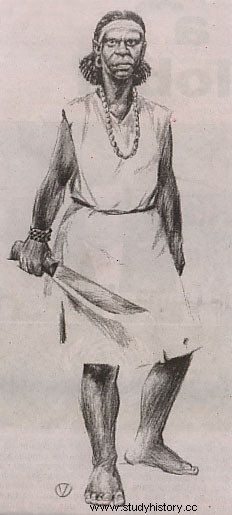In 1843, Carlota Lucumi (or Lukumi) was one of the leaders of the Triunvirato revolt in Cuba, against slavery and against the masters. She is considered a heroine and a martyr in the fight against slavery.
“My friend”
Although Carlota Lucumi was an emblematic figure of the slave revolts in the European colonies in America, we know very little about her existence. Sources concerning the life of slaves are rare, and often to be considered with caution:most of the information comes from testimonies of slaves obtained during periods of repression, by the colonial authorities; witnesses are then forced to watch what they say so as not to put their own existence in danger.

Born in 19 e century, Carlota belongs to the lucumi people (“my friend”, in Yoruba), descendants of the Yoruba people originating from West Africa (Nigeria, Benin, Ghana, Togo, Ivory Coast), and reduced to slavery in Cuba by European settlers as part of the triangular trade. Carlota is herself a slave to the ingenio (the sugar cane mill) of Triunvirato (in the province of Matanzas, east of Havana in Cuba), owned by Julian Alfonso y Soler. On his life, testimonies from slaves mention a violent attack on the daughter of a foreman. And in 1843, when a slave revolt broke out, Carlota was one of its leaders.
Cuba under Spanish colonization
Cuba was then under Spanish domination and this – apart from a brief English occupation in 1762 – since 1511 with the arrival of the first conquistadors, including Diego Velázquez de Cuéllar and Hernán Cortés. The Amerindians of the island – between 15,000 and 60,000 members of various populations, Taïnos and Caribs in the lead – were quickly decimated by the diseases that came with the conquistadors and the cruel conditions of slavery to which they were reduced.
The Amerindians were gradually replaced by African slaves, the first of whom set foot on the island in 1513. But it was mainly from the end of the
18
e
century that their number increased massively:from the beginning of the Haitian revolution in 1791, many French settlers fled the neighboring island of Santo Domingo and took refuge in Cuba with their slaves. Slavery is much more important there, and the Spanish colonists in turn undertake to bring more and more slaves from Africa, mainly Yoruba, Bantu, Fon, Ewe, Abakuá, and other peoples of West Africa. In 1790, Cuba had 85,000 slaves; there were 287,000 in 1827.
The island's slaves are exploited mainly in coffee and sugar cane plantations, in unbearable working conditions. Forcibly converted to Christianity, the Lucumi practice a syncretic religion based on the Yoruba religion, the Regla de Ocha or Regla lucumí , pejoratively nicknamed santería by Spanish settlers.
Slave revolts
The massive influx of slaves, the extension of plantations, the intensification of farming methods or even the example of the Haitian revolution - which led to its independence in 1804 -, so many upheavals that agitated Cuba during the first half of the 19 th century and which, among white settlers, revived the greatest terror:that of slave revolts. Several broke out in the 1830s and 1840s, against deprivation of freedom and inhuman working conditions, but were quickly suppressed. In a letter from December 1843, the Cuban politician Miguel de Aldama, who came from a family wealthy in the sugar trade, noted as follows:
“Se nota cada dia mayor firmza en ellos, mayor tendencia a rebellion y a disputar a viva fuerza sus derechos. Afortunadamante en nuestras fincas siguen hasta lo presente en la mayor tranquilidad – Pero, ¿ extrañariamos que hombres esclavos se levantaran y pelearan por su libertad? »
(Every day they show greater steadfastness, a greater tendency to revolt and to fight hard for their rights, with force. Fortunately, on our farms they have been very quiet so far – But should it be any wonder that slave men stand up and fight for their freedom?)
The stopover
The year 1843 was indeed turbulent with slave revolts on the plantations and the ingenios . Insurrections that are coordinated under the noses of the colonists:the slaves indeed communicate to the sound of drums, from plantation to plantation. At the ingenio
Acana , two Lucumis slaves, Evaristo and Fermina, strive to sound the call to revolt. It bursts, at the ingenio of Triunvirato, November 5, 1843, and spread rapidly to neighboring plantations through an efficient system of communication.

Carlota Lucumi is one of the leaders of the revolt, along with other slaves named Eduardo, Narciso, Felipe Lucumí and Manuel Gangá. The insurgents burn the houses of masters and mills, free slaves, attack masters and foremen, attack coffee and sugar cane crops, and strive to spread the movement, which gains five plantations, in Ácana, in Concepción, in San Lorenzo, in San Miguel, in San Rafael.
The reprisals will be terrible. The revolt is violently suppressed and many slaves are killed – fifty to sixty for the ingenio alone of Triunvirato, from the end of November. Carlota is arrested and executed in a particularly brutal way, at the ingenio San Rafael, in March 1844. The revolts of 1843 would later be known as
La Escalera (the ladder), named after a torture technique widely used against slaves during the wave of repression…
Cuba would not abolish slavery until 1886 – and would be one of the last European colonies to do so. After several wars, the island's independence was recognized in 1902. Carlota Lucumí remains an emblematic figure in the Afro-Cuban struggle against slavery.
